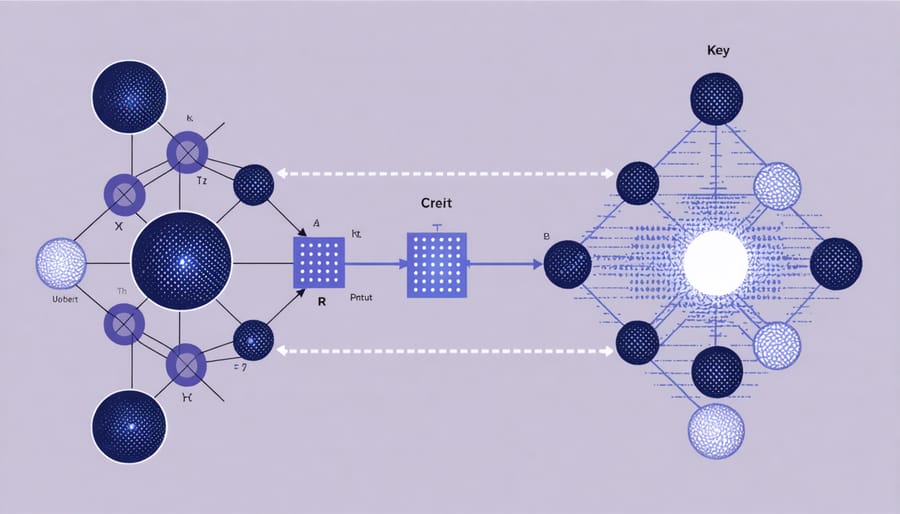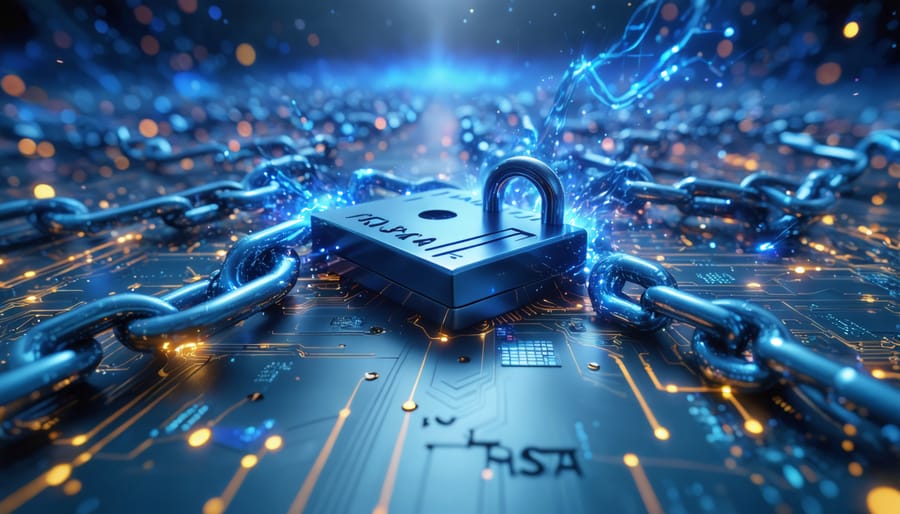Quantum computing’s emergence represents an unprecedented threat to current cryptographic systems, with experts predicting that quantum computers could break widely-used RSA encryption within the next decade. Organizations must urgently implement quantum-resistant security measures to protect their digital infrastructure against this looming cybersecurity challenge. The convergence of quantum computing capabilities and existing security protocols creates a critical vulnerability window where traditional encryption methods become increasingly susceptible to quantum attacks.
This next-generation computing paradigm will fundamentally reshape the cybersecurity landscape, requiring a complete overhaul of existing security frameworks and encryption standards. The National Institute of Standards and Technology (NIST) estimates that 20% of current cryptographic systems will be vulnerable to quantum attacks by 2030, highlighting the immediate need for quantum-resistant protocols. Industry leaders are already developing post-quantum cryptography solutions, combining advanced mathematical algorithms with quantum-resistant properties to safeguard critical data and communications infrastructure.
This article explores the essential strategies, technologies, and implementation frameworks necessary for organizations to prepare for the quantum computing era, ensuring long-term data protection and operational resilience against emerging quantum threats.
The Quantum Threat to Critical Infrastructure
Breaking Traditional Encryption
Quantum computers pose a significant threat to current encryption standards, particularly RSA (Rivest-Shamir-Adleman) encryption, which secures much of today’s critical infrastructure. The fundamental challenge lies in quantum computers’ ability to perform complex mathematical calculations exponentially faster than classical computers through quantum superposition and entanglement.
Using Shor’s Algorithm, a quantum computer with sufficient qubits could factor large numbers – the cornerstone of RSA encryption – in hours rather than the millions of years required by classical computers. This capability effectively renders current public-key cryptography vulnerable to breach, potentially exposing sensitive infrastructure control systems, secure communications, and data storage.
For example, a 2048-bit RSA key, currently considered highly secure, could be broken by a quantum computer with approximately 4,000 error-corrected qubits. While current quantum computers haven’t yet achieved this capability, experts project this threshold could be reached within the next decade.
The impact extends beyond RSA to other widely-used cryptographic systems, including elliptic curve cryptography (ECC) and Diffie-Hellman key exchange protocols. These systems rely on similar mathematical principles that quantum computers can efficiently solve, creating a comprehensive threat to existing security infrastructure.
Construction organizations must understand that while quantum computers aren’t yet capable of breaking these encryption methods, the timeline for quantum-resistant security implementation often exceeds the projected arrival of capable quantum systems.

Vulnerable Infrastructure Systems
The advent of quantum computing poses unprecedented risks to our vital infrastructure systems, particularly those relying on current cryptographic protections. Modern critical infrastructure protection systems face potential vulnerabilities that could be exploited once quantum computers achieve sufficient processing power.
Power grids represent one of the most vulnerable sectors, with their increasing reliance on digital control systems and smart grid technology. These systems currently employ standard encryption protocols that could be compromised by quantum algorithms, potentially enabling unauthorized access to grid controls and distribution networks.
Building management systems (BMS) present another critical concern, as they control essential functions like HVAC, access control, and emergency systems across commercial and industrial facilities. The interconnected nature of modern BMS makes them particularly susceptible to quantum-enabled breaches, which could compromise entire building networks.
Industrial control systems (ICS) and SCADA networks, which manage critical manufacturing processes and utility operations, are equally at risk. These systems often rely on legacy security protocols and were not designed with quantum threats in mind. A breach in these systems could lead to production shutdowns, equipment damage, or even safety incidents.
Water treatment facilities, transportation systems, and telecommunications infrastructure also require immediate attention to address quantum computing vulnerabilities. Organizations must begin implementing quantum-resistant security measures to protect these essential services from future threats.
Quantum-Enhanced Security Solutions
Quantum Key Distribution (QKD)
Quantum Key Distribution (QKD) represents a groundbreaking approach to securing infrastructure communications by leveraging quantum mechanics principles. This technology enables two parties to generate a shared random secret key that can be used to encrypt and decrypt messages with theoretically unbreakable security.
In infrastructure applications, QKD systems typically utilize fiber optic networks to transmit individual photons between secure locations. The fundamental security principle relies on the quantum mechanical property that measuring a quantum state inevitably disturbs it, making it impossible for an eavesdropper to intercept communications without detection.
Recent implementations have demonstrated QKD’s practical viability in protecting critical infrastructure. For example, a major European power grid operator successfully deployed QKD to secure communications between substations, achieving continuous operation over distances exceeding 100 kilometers. The system detected and prevented several attempted security breaches during its initial deployment phase.
However, implementing QKD in infrastructure settings presents unique challenges. The technology requires specialized hardware, including quantum random number generators, precise timing systems, and ultra-sensitive photon detectors. Environmental factors such as temperature fluctuations and vibrations can affect system performance, necessitating robust installation protocols and regular maintenance.
Cost considerations remain significant, with current estimates ranging from $100,000 to $500,000 per link, depending on distance and security requirements. Despite the high initial investment, many organizations consider QKD essential for future-proofing their security infrastructure against quantum computing threats.
Best practices for QKD implementation include:
– Conducting thorough site surveys to assess environmental conditions
– Establishing redundant quantum channels for reliability
– Implementing comprehensive monitoring systems
– Training personnel in quantum-safe security protocols
– Developing incident response procedures specific to quantum communications
As quantum computing capabilities advance, QKD’s role in infrastructure security will likely expand, particularly in sectors requiring long-term data protection such as healthcare, financial services, and government facilities.

Post-Quantum Cryptography
As quantum computing capabilities advance, the cybersecurity community is actively developing post-quantum cryptography (PQC) solutions to protect critical infrastructure systems against future quantum threats. These quantum-resistant algorithms are designed to withstand attacks from both classical and quantum computers, ensuring long-term security for sensitive data and communications.
The National Institute of Standards and Technology (NIST) is leading the standardization effort for PQC algorithms, with several promising candidates emerging from their evaluation process. Lattice-based cryptography has shown particular promise, offering strong security guarantees while maintaining reasonable computational efficiency. This approach uses complex mathematical structures that remain difficult to solve even with quantum computing capabilities.
Other notable quantum-resistant approaches include hash-based signatures, multivariate cryptography, and code-based cryptography. Each offers distinct advantages and trade-offs in terms of key size, processing speed, and implementation complexity. Infrastructure operators are particularly interested in hybrid solutions that combine traditional cryptographic methods with post-quantum algorithms, providing a pragmatic transition path while maintaining backward compatibility.
Major technology providers are already implementing PQC prototypes in their infrastructure security solutions. Early adopters in critical infrastructure sectors are conducting pilot programs to evaluate these algorithms in real-world environments, focusing on performance impact and integration challenges with existing systems.
For infrastructure organizations, the key consideration is developing a quantum-ready security strategy that includes regular security assessments, cryptographic agility in system design, and a clear roadmap for implementing post-quantum solutions as they become standardized. This proactive approach helps ensure continued protection of critical assets against emerging quantum threats.
Hybrid Security Approaches
In the rapidly evolving landscape of cybersecurity, organizations are increasingly adopting hybrid approaches that combine quantum-resistant algorithms with traditional security measures. This strategic combination provides a robust defense mechanism during the transition period to quantum-capable systems while maintaining current security standards.
Infrastructure providers are implementing layered security architectures that integrate post-quantum cryptography (PQC) with existing cryptographic protocols. This approach ensures continued protection against both conventional cyber threats and potential quantum computer attacks. For example, major utilities are now deploying hybrid certificates that incorporate both classical RSA algorithms and quantum-resistant lattice-based cryptography.
Key elements of successful hybrid security implementations include:
– Quantum-safe key encapsulation mechanisms running parallel to current public-key systems
– Dual-signature schemes that validate transactions using both classical and quantum-resistant algorithms
– Adaptive security frameworks that can transition smoothly between different cryptographic methods
Industry leaders are particularly focused on developing hybrid solutions for critical infrastructure components such as SCADA systems, smart grid networks, and industrial control systems. These implementations typically feature modular designs that allow for gradual updates and replacements of security components as quantum technologies mature.
The hybrid approach also addresses practical considerations such as backward compatibility with legacy systems and maintaining operational efficiency. Organizations can thus protect their infrastructure investments while preparing for quantum computing challenges, ensuring both immediate security needs and future-ready capabilities are met.
Implementation Challenges and Solutions

Infrastructure Integration
Integrating quantum-resistant security measures into existing infrastructure systems presents significant technical challenges that require careful planning and execution. Organizations must first conduct comprehensive vulnerability assessments to identify systems susceptible to quantum computing threats. This process should align with established infrastructure threat detection protocols while incorporating quantum-specific considerations.
Key technical requirements include upgrading cryptographic systems to quantum-resistant algorithms, implementing secure key distribution networks, and establishing quantum-safe communication channels. Organizations must ensure their hardware infrastructure can support post-quantum cryptography (PQC) solutions, which often require greater computational resources than traditional cryptographic methods.
Implementation challenges typically revolve around three core areas: legacy system compatibility, performance optimization, and scalability. Legacy systems may require substantial modifications or complete replacement to accommodate quantum-safe protocols. Performance impact must be carefully managed, as quantum-resistant algorithms can introduce additional latency and processing overhead. Scalability concerns arise from the need to maintain consistent security across distributed infrastructure networks.
Success factors include phased implementation approaches, robust testing protocols, and comprehensive staff training programs. Organizations should establish clear migration pathways that minimize disruption while maintaining security integrity throughout the transition period. Regular security audits and updates must be incorporated into the maintenance schedule to ensure continued protection against evolving quantum threats.
Cost and Timeline Considerations
Implementing quantum-safe cybersecurity measures requires significant financial investment and careful timeline planning. Based on industry analysis, organizations should expect to allocate between 15-25% of their existing cybersecurity budget for quantum-resistant upgrades over the next 3-5 years. This includes costs for hardware updates, cryptographic transitions, and specialized training programs.
The transition timeline typically spans 24-36 months, divided into three primary phases. The initial assessment and planning phase (4-6 months) involves infrastructure evaluation and risk analysis. The implementation phase (12-18 months) covers the gradual deployment of quantum-resistant algorithms and security protocols. The final integration and testing phase (6-12 months) ensures system compatibility and operational effectiveness.
Key cost considerations include quantum-resistant encryption systems ($50,000-$200,000), infrastructure upgrades ($100,000-$500,000), and ongoing maintenance (approximately 20% of initial investment annually). Organizations must also factor in potential productivity impacts during the transition period, estimated at 5-10% temporary efficiency reduction.
Early adopters report that proactive implementation, while initially more costly, proves more economical than reactive measures. Industry experts recommend a phased approach to distribute costs over time, starting with critical systems and gradually expanding to peripheral infrastructure. This strategy allows organizations to maintain operational continuity while managing budget constraints effectively.
As we stand on the brink of the quantum computing era, the imperative to fortify our infrastructure against quantum threats has never been more critical. The transition to quantum-safe security measures isn’t just a technical challenge – it’s a strategic necessity that requires immediate attention and systematic implementation across all critical infrastructure sectors.
Professional stakeholders must prioritize several key actions: conduct thorough quantum risk assessments, develop comprehensive migration strategies to quantum-resistant algorithms, and implement robust infrastructure security solutions that can withstand both current and future threats. The investment in quantum-safe security measures today will prove far less costly than addressing quantum vulnerabilities after they’ve been exploited.
Industry leaders should focus on three essential steps: first, establish a quantum-ready security framework that aligns with organizational goals and compliance requirements; second, invest in staff training and technical expertise to manage quantum-safe implementations; and third, maintain flexible security architectures that can adapt to emerging quantum standards and protocols.
The path to quantum-safe infrastructure requires collaboration between security professionals, technology vendors, and regulatory bodies. By taking proactive steps now, organizations can ensure their critical systems remain protected as quantum computing capabilities evolve, maintaining both operational integrity and stakeholder confidence in our increasingly connected world.

